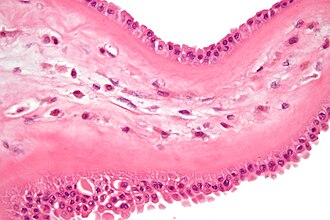Difference between revisions of "Placental meconium"
Jump to navigation
Jump to search
(split-out) |
m |
||
| Line 28: | Line 28: | ||
| ClinDDx = | | ClinDDx = | ||
}} | }} | ||
'''Placental meconium''', also known as ''' | '''Placental meconium''', also known as '''meconium staining''', is associated with fetal distress. | ||
==General== | ==General== | ||
| Line 104: | Line 104: | ||
*[[Placenta]]. | *[[Placenta]]. | ||
*[[Chorioamnionitis]]. | *[[Chorioamnionitis]]. | ||
*[[Meconium peritonitis]]. | |||
*[[Meconium ileus]]. | |||
==References== | ==References== | ||
Revision as of 13:02, 27 September 2013
| Placental meconium | |
|---|---|
| Diagnosis in short | |
 Meconium-laden macrophages. H&E stain. | |
|
| |
| LM | macrophages with brown fine granular pigment in the amnion +/- chorion |
| LM DDx | hemorrhage |
| Stains | PASD +ve, Prussian blue -ve |
| Gross | green discolourization of fetal membranes |
| Site | placental membranes |
|
| |
| Associated Dx | +/-chorioamnionitis |
| Clinical history | +/-non-reassuring fetal heart rate |
| Prevalence | uncommon |
| Prognosis | benign |
Placental meconium, also known as meconium staining, is associated with fetal distress.
General
- Associated with fetal distress.
- Small amount - at term - is considered to be normal.
Other meconium-related pathology:
Gross
- Fetal membranes with a green discolourization.
Microscopic
Features:[1]
- Meconium histiocytes - key feature.
- Macrophages with brown fine granular pigment.
- Pseudostratified epithelium (amnion) - low power.
- Amnion - columnar morphology (normally cuboidal).
- "Drop-out" of individual amnion cells / loss of individual cells.
Time of meconium passage:[2]
- <1 h - no staining of membranes.
- 1-3 h - amnion is stained.
- >3 h - chorion is stained.
DDx:
- Hemosiderin-laden macrophages.
- This is sorted-out with an iron stain -- see below.
Notes:
- The above time course is disputed - in vitro experiments suggest it is considerably longer.[3]
Images
Special stains
- Hemosiderin +ve in hemosiderin-laden macrophages.
- PAS +ve in meconium-laden macrophages.[4]
Useful to differentiate hemosiderin-laden macrophages and meconium laden macrophages:
- Hemosiderin stain -- +ve for old blood.
- Prussian-blue stain = hemosiderin stain.[5]
Notes:
- PAS-D -- +ve in meconium... though may rarely stain hemosiderin.
- Meconium contains bile.[6]
Sign out
PLACENTA, UMBILICAL CORD AND FETAL MEMBRANES, BIRTH: - FETAL MEMBRANES WITH MECONIUM-LADEN MACROPHAGES, NEGATIVE FOR CHORIOAMNIONITIS. - THREE VESSEL UMBILICAL CORD WITHIN NORMAL LIMITS. - PLACENTAL DISC WITH THIRD TRIMESTER VILLI WITHIN NORMAL LIMITS.
COMMENT: A PAS-D stain and Prussian blue stain were used to confirm the presence of meconium.
Not definite
PLACENTA, UMBILICAL CORD AND FETAL MEMBRANES, CESAERIAN SECTION: - EARLY CHORIOAMNIONITIS. - FETAL MEMBRANES WITH FOCAL AMNION CELL DROP-OUT AND RARE PIGMENTED CELLS SUGGESTIVE OF MECONIUM. - THREE VESSEL UMBILICAL CORD WITHIN NORMAL LIMITS. - PLACENTAL DISC WITH THIRD TRIMESTER VILLI.
See also
References
- ↑ ALS. 6 Febraury 2009.
- ↑ Miller PW, Coen RW, Benirschke K (October 1985). "Dating the time interval from meconium passage to birth". Obstet Gynecol 66 (4): 459–62. PMID 2413412.
- ↑ Funai EF, Labowsky AT, Drewes CE, Kliman HJ (January 2009). "Timing of fetal meconium absorption by amnionic macrophages". Am J Perinatol 26 (1): 93–7. doi:10.1055/s-0028-1103028. PMID 19031358.
- ↑ Povýsil C, Bennett R, Povýsilová V (January 2001). "CD 68 positivity of the so-called meconium corpuscles in human foetal intestine". Cesk Patol 37 (1): 7–9. PMID 11268705.
- ↑ Sienko A, Altshuler G (September 1999). "Meconium-induced umbilical vascular necrosis in abortuses and fetuses: a histopathologic study for cytokines". Obstet Gynecol 94 (3): 415?0. PMID 10472870.
- ↑ Sienko A, Altshuler G (September 1999). "Meconium-induced umbilical vascular necrosis in abortuses and fetuses: a histopathologic study for cytokines". Obstet Gynecol 94 (3): 415?0. PMID 10472870.

